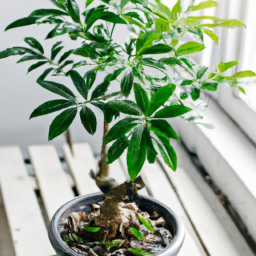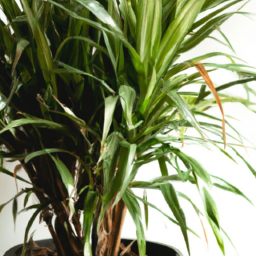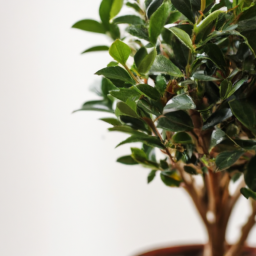
Are you looking to add some greenery to your indoor space but worried about your lack of a green thumb? Fear not, because in this blog post, we will be discussing the easiest indoor trees to keep alive. Whether you’re a seasoned plant parent or a newbie looking to dip your toes into the world of indoor gardening, these low-maintenance trees are sure to thrive in your home with minimal effort. Let’s dive in and discover which indoor trees are the perfect fit for your space!
Best Indoor Trees for Beginners: Easy to Care for Options
Choosing the Right Indoor Tree for Your Space
When it comes to selecting an indoor tree for your home, it’s important to consider the amount of natural light available in the room. Some trees thrive in bright, direct sunlight, while others prefer indirect light or even low light conditions. Additionally, think about the size of the tree and how much space you have available. Some indoor trees can grow quite large over time, so make sure you have enough room for your tree to flourish.
Once you’ve determined the lighting and space requirements, consider the level of maintenance you’re willing to commit to. Some indoor trees require regular watering, pruning, and fertilizing, while others are more low-maintenance. If you’re a beginner or don’t have a green thumb, opt for a tree that is easy to care for and forgiving of occasional neglect.
Top Easy-to-Care-for Indoor Trees
1. **Snake Plant (Sansevieria)** – This popular indoor plant is perfect for beginners, as it can thrive in low light and only needs to be watered occasionally. The snake plant is also known for its air-purifying qualities, making it a great choice for improving indoor air quality.
2. **Fiddle Leaf Fig (Ficus lyrata)** – The fiddle leaf fig is a trendy indoor tree that adds a touch of elegance to any space. While it does require bright, indirect light, it is relatively low-maintenance when it comes to watering and pruning. Just be sure not to overwater, as this can lead to root rot.
3. **Money Tree (Pachira aquatica)** – The money tree is believed to bring good luck and prosperity, making it a popular choice for indoor plant enthusiasts. This tree thrives in bright, indirect light and only needs to be watered when the top inch of soil is dry. With its braided trunk and lush green leaves, the money tree is sure to brighten up any room.
4. **Rubber Plant (Ficus elastica)** – The rubber plant is a hardy indoor tree that can tolerate low light conditions and infrequent watering. Its thick, glossy leaves add a touch of tropical flair to any space, making it a popular choice for beginners looking to add some greenery to their home.
5. **Parlor Palm (Chamaedorea elegans)** – The parlor palm is a classic indoor tree that is well-suited for low light conditions. This tree is relatively low-maintenance and only needs to be watered when the top inch of soil is dry. With its feathery fronds and compact size, the parlor palm is a versatile option for any indoor space.
Tips for Keeping Your Indoor Tree Alive and Thriving
1. **Watering** – One of the most common mistakes people make with indoor trees is overwatering. Make sure to check the soil moisture before watering and only water when the top inch of soil is dry. It’s better to underwater than overwater, as most indoor trees prefer slightly dry conditions.
2. **Lighting** – Pay attention to the lighting requirements of your indoor tree and place it in a spot where it will receive the appropriate amount of light. If your tree starts to look leggy or droopy, it may not be getting enough light. Consider moving it to a brighter location or supplementing with a grow light.
3. **Pruning** – Regular pruning is essential for maintaining the health and shape of your indoor tree. Remove any dead or yellowing leaves, as well as any branches that are crossing or rubbing against each other. Pruning will help promote new growth and keep your tree looking its best.
By choosing the right indoor tree for your space and following these tips for care and maintenance, you can enjoy the beauty of nature indoors without the stress of high-maintenance plants. Remember to observe your tree regularly and adjust your care routine as needed to ensure it stays healthy and thriving.

Low Maintenance Indoor Trees That Thrive in Any Environment
Choosing the Right Indoor Tree
When it comes to choosing an indoor tree that is easy to care for, there are a few key factors to consider. First, think about the amount of light your space receives. Some indoor trees thrive in bright, indirect light, while others can tolerate lower light conditions. Consider the size of the tree as well – make sure it will fit comfortably in your space without overcrowding. Finally, think about your own schedule and how much time you can realistically dedicate to caring for your tree. Some indoor trees require more frequent watering and maintenance than others.
One popular choice for a low maintenance indoor tree is the Snake Plant. This hardy plant can thrive in a variety of light conditions, from bright indirect light to low light. It also requires very little water, making it perfect for busy plant owners. Another great option is the ZZ Plant, which is known for its ability to thrive in low light and its resistance to pests and diseases. The Pothos is another low maintenance indoor tree that is perfect for beginners. It can tolerate a variety of light conditions and only needs to be watered when the soil is dry to the touch.
When choosing an indoor tree, make sure to consider the specific care requirements of each plant. Some trees may need to be fertilized regularly, while others may need to be pruned occasionally. By choosing a tree that fits your space and lifestyle, you can ensure that your indoor tree will thrive with minimal effort.
Caring for Your Indoor Tree
Once you have chosen the perfect indoor tree for your space, it is important to provide it with the proper care to ensure its health and longevity. One of the most important factors in caring for an indoor tree is watering. Most indoor trees prefer to be watered when the top inch of soil is dry to the touch. Overwatering can lead to root rot, while underwatering can cause the tree to become stressed and wilted. Make sure to water your tree consistently, but be mindful not to overdo it.
In addition to watering, it is important to provide your indoor tree with the proper light conditions. Most indoor trees prefer bright, indirect light, but some can tolerate lower light conditions. Make sure to place your tree in a location where it will receive the appropriate amount of light for its specific needs. If you notice that your tree is not thriving in its current location, try moving it to a spot with better light conditions.
Regularly dusting the leaves of your indoor tree can also help to keep it healthy. Dust can block sunlight and prevent the tree from photosynthesizing properly. Use a damp cloth to gently wipe down the leaves of your tree every few weeks to keep it looking its best. Pruning dead or yellowing leaves can also help to promote new growth and keep your tree looking neat and tidy.
Troubleshooting Common Issues
Even the easiest indoor trees can sometimes run into problems. If you notice that your tree’s leaves are turning yellow or brown, it may be a sign of overwatering or underwatering. Adjust your watering schedule accordingly and make sure that your tree is receiving the right amount of light. If your tree is losing leaves or not growing as well as it should, it may need to be fertilized. Choose a balanced houseplant fertilizer and follow the instructions on the packaging to give your tree the nutrients it needs to thrive.
Pests can also be a common issue for indoor trees. Keep an eye out for signs of pests such as spider mites, mealybugs, or scale insects. If you notice any pests on your tree, gently wipe them off with a damp cloth or use an insecticidal soap to get rid of them. Regularly inspecting your tree for pests and treating them promptly can help to keep your tree healthy and pest-free.
By choosing the right indoor tree for your space, providing it with the proper care, and addressing any issues that arise promptly, you can enjoy a beautiful and thriving indoor tree with minimal effort. With a little bit of attention and care, your indoor tree can bring life and beauty to your space for years to come.

Top 3 Indoor Trees That Require Minimal Effort to Keep Alive
Choosing the Right Indoor Tree
When it comes to choosing an indoor tree that is easy to care for, there are a few key factors to consider. First and foremost, you’ll want to select a tree that thrives in indoor environments, such as low light and consistent temperatures. Some trees are better suited for indoor living than others, so it’s important to do your research before making a decision.
One popular choice for an indoor tree that requires minimal effort to keep alive is the Fiddle Leaf Fig. This tree is known for its large, glossy leaves and can thrive in a variety of lighting conditions, making it a versatile option for any indoor space. Another great option is the Snake Plant, which is incredibly low maintenance and can survive in low light and dry conditions. Lastly, the Rubber Plant is a great choice for those looking for a tree that is easy to care for and can thrive in a variety of indoor environments.
When selecting an indoor tree, be sure to consider the amount of space you have available, as well as the lighting conditions in your home. It’s also important to consider your own schedule and level of experience with caring for plants, as some trees may require more attention than others. By taking these factors into account, you can choose an indoor tree that is well-suited to your lifestyle and living space.
Caring for Your Indoor Tree
Once you’ve selected the perfect indoor tree for your space, it’s important to provide it with the proper care to ensure its health and longevity. One of the most important factors in caring for an indoor tree is providing it with the right amount of water. Overwatering can be just as harmful as underwatering, so be sure to monitor the soil moisture and adjust your watering schedule accordingly.
In addition to water, indoor trees also require regular fertilization to provide them with the nutrients they need to thrive. Be sure to use a high-quality, balanced fertilizer and follow the instructions on the packaging for best results. It’s also important to regularly dust the leaves of your indoor tree to keep them clean and free of debris, which can inhibit their ability to photosynthesize.
Another key aspect of caring for an indoor tree is monitoring its growth and health. Keep an eye out for any signs of pests or disease, such as yellowing leaves or unusual spots, and take action promptly to address any issues. Regularly pruning your indoor tree can also help to promote healthy growth and maintain its shape.
By providing your indoor tree with the proper care and attention, you can enjoy a beautiful and thriving plant in your home for years to come. Remember to research the specific care requirements of your chosen tree and tailor your care routine accordingly to ensure its success.
Troubleshooting Common Issues
Even with the best care and attention, indoor trees can sometimes encounter issues that may affect their health and appearance. One common issue that indoor trees face is root rot, which can occur when the roots are exposed to excess moisture for an extended period of time. To prevent root rot, be sure to provide your indoor tree with well-draining soil and avoid overwatering.
Another common issue that indoor trees may face is pest infestations, such as spider mites or mealybugs. If you notice any signs of pests on your indoor tree, such as webbing or sticky residue, it’s important to take action promptly to prevent further damage. There are a variety of natural and chemical treatments available to help control pest infestations and protect your indoor tree.
In addition to pests and diseases, indoor trees may also experience issues related to lighting and temperature. If your indoor tree is not receiving enough light, it may become leggy or develop pale leaves. Consider moving your tree to a brighter location or supplementing its light with a grow light to promote healthy growth. Similarly, indoor trees may be sensitive to extreme temperatures, so be sure to keep your tree away from drafts or heating vents to prevent stress.
By being proactive and attentive to the needs of your indoor tree, you can address any issues that arise and ensure its continued health and vitality. Remember to research the specific care requirements of your chosen tree and seek advice from a professional if you encounter any challenges along the way. With the right care and attention, your indoor tree can thrive and enhance the beauty of your home for years to come.
Key Takeaways
Are you looking to add some greenery to your indoor space but worried about keeping a plant alive? Fear not, because there are plenty of easy-to-care-for indoor trees that even the most novice plant parent can keep alive and thriving. One popular option is the rubber tree, known for its low maintenance and ability to adapt to various light conditions. With its glossy leaves and striking appearance, the rubber tree is a great choice for adding a touch of nature to your home without the stress of constant upkeep.
Another easy indoor tree to care for is the spider plant, which is not only visually appealing with its long, arching leaves but also known for its air-purifying qualities. Spider plants thrive in indirect sunlight and require minimal watering, making them a perfect choice for those who tend to forget about their plants. With these easy-to-care-for indoor trees, you can enjoy the benefits of having greenery in your home without the worry of constantly tending to them. So go ahead and bring some life into your space with these low-maintenance indoor tree options.
Q&A Corner:
Q1. What are some of the easiest indoor trees to keep alive?
A1. Some of the easiest indoor trees to keep alive include the spider plant, rubber tree, pothos, peace lily, and snake plant. These plants are low-maintenance and can thrive in various indoor environments.
Q2. How often do I need to water indoor trees?
A2. The watering frequency for indoor trees can vary depending on the type of tree and its specific needs. In general, it’s best to water when the top inch of soil feels dry to the touch. Overwatering can be harmful to indoor trees, so it’s important to monitor the soil moisture levels regularly.
Q3. Do indoor trees need sunlight?
A3. Yes, indoor trees do need sunlight to thrive. While some indoor trees can tolerate low light conditions, most prefer bright, indirect sunlight. It’s important to place your indoor tree near a window where it can receive adequate sunlight to promote healthy growth.
Q4. How can I prevent pests from infesting my indoor trees?
A4. To prevent pests from infesting your indoor trees, it’s important to regularly inspect your plants for any signs of pests such as spider mites or mealybugs. You can also wipe down the leaves of your indoor trees with a damp cloth to remove any dust or potential pests. Additionally, avoid overwatering your plants as this can attract pests.
Q5. What are some tips for caring for indoor trees?
A5. Some tips for caring for indoor trees include providing adequate sunlight, watering when the top inch of soil is dry, using well-draining soil, and occasionally fertilizing your plants. It’s also important to regularly dust the leaves of your indoor trees to ensure they can photosynthesize efficiently.

James Wong is a renowned ethnobotanist, plant scientist, and local television presenter. With a passion for demystifying plant science, he is known for translating complex botanical concepts into practical advice for everyday plant enthusiasts. James’s expertise spans from traditional gardening to cutting-edge plant technologies, making his insights accessible and informative.


